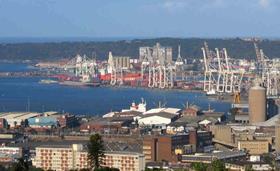
Congestion around the port of Durban in South Africa is hampering the country's citrus export programme at a time when producers are keen to take advantage of favourable exchange rates and strong demand in international markets.
That's the view of key suppliers as well as industry body the South African Citrus Growers Association (CGA), which confirmed that coldstorage facilities in Durban were generally full or at high capacity and containers arriving at the port were blocking entrances.
Crucially, a four-day protocol imposed because of citrus black spot is apparently being breached due to delays caused by trucks arriving at the port creating a bottleneck and thus hampering inspections by the Department of Agriculture, Forestry and Fisheries.
'I have been advised that shipping through Durban earlier last week has not been sufficient to make way for Valencia railings entering Durban,' commented CGA spokesman Mitchell Brooke.
'Slow shipments through the port have resulted in capacity constraints and were expected to result in truck bottlenecks.'
He added that, where possible, conventional reefers had been brought in to alleviate the problem.
Although most of South Africa's navel, grapefruit and soft citrus crop has already been shipped, exports of the country's sizeable Valencia crop are just getting underway, with a high portion of the fruit grown in northern areas destined for Durban.
Forecast in doubt
South Africa's latest citrus export crop prediction places the total volume to be shipped at 105m cartons, above last year's 103m cartons.
By mid-August, shipments were already over the 60m-carton mark, but industry insiders said they were concerned about the effect that continued congestion in Durban would have on the export deal.
With the build-up of traffic affecting shipping rates, transporters are also reported to be increasingly reluctant to transport fruit from the growing areas to the port.
'On a weekly basis we see high demand areas in the middle of the week where up to 10 vessel stacks open simultaneously over a three-day period in the middle of the week,' explained Brooke.
'This means that the coldstores are required to load out all the planned containers in a space of three to four days, something which is simply not achievable.'
A full report on South African citrus exports will be published in the October 2013 issue of Eurofruit. To secure your copy, visit fruitnet.com/eurofruit/subscribe to subscribe.



